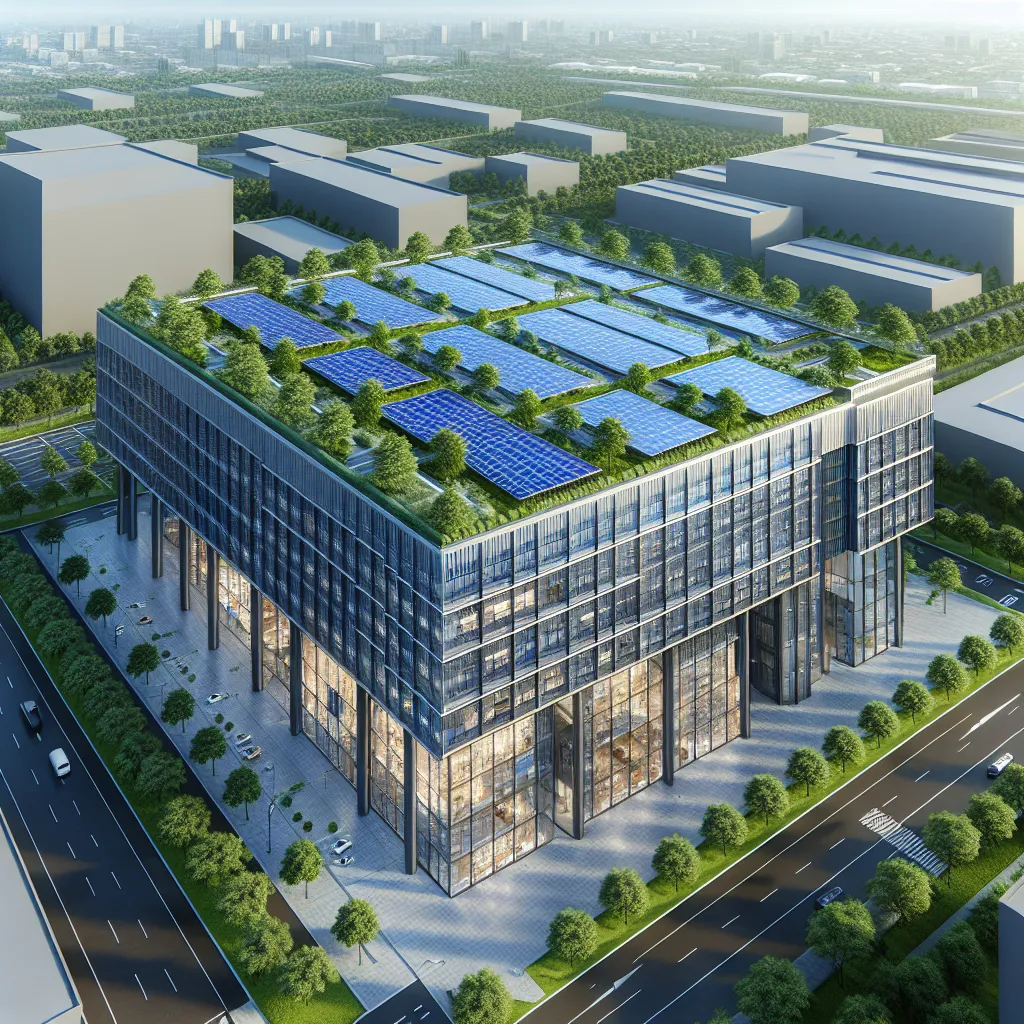The IELTS Reading section tests your ability to understand and analyze complex texts on various topics. One recurring theme in recent years has been energy efficiency, particularly in urban environments. Based on our analysis of past IELTS exams, the topic of reducing energy use in commercial buildings has appeared multiple times, making it a highly relevant subject for test-takers to study.
Given the growing global focus on sustainability and climate change, it’s likely that this theme will continue to be featured in future IELTS exams. To help you prepare, we’ve created a practice reading passage and questions on this topic, mirroring the format and difficulty level you might encounter in the actual test.
Practice Reading Passage
How to Reduce Energy Use in Commercial Buildings
Commercial buildings are significant consumers of energy, accounting for a large portion of urban energy use. As cities strive to become more sustainable, finding ways to reduce energy consumption in these structures has become a priority. This article explores various strategies and technologies that can be implemented to enhance energy efficiency in commercial buildings.
One of the most effective approaches to reducing energy use is through improved building design. Modern architectural techniques prioritize energy efficiency from the ground up. For instance, the orientation of a building can be optimized to maximize natural light and minimize heat gain, reducing the need for artificial lighting and cooling. Additionally, the use of high-performance insulation materials and double or triple-glazed windows can significantly decrease heat transfer, lowering the demand for heating and cooling systems.
 Energy-efficient commercial building
Energy-efficient commercial building
Upgrading lighting systems is another crucial step in reducing energy consumption. LED lights, which use up to 75% less energy than traditional incandescent bulbs, have become increasingly popular in commercial settings. Moreover, the implementation of smart lighting systems that adjust brightness based on occupancy and natural light levels can further reduce unnecessary energy use.
HVAC (Heating, Ventilation, and Air Conditioning) systems typically account for a significant portion of a commercial building’s energy consumption. Upgrading to high-efficiency HVAC equipment and implementing smart control systems can lead to substantial energy savings. These smart systems can adjust temperature and ventilation based on occupancy patterns and external weather conditions, ensuring optimal comfort while minimizing energy waste.
The integration of renewable energy sources, particularly solar panels, has become increasingly common in commercial buildings. Rooftop solar installations can offset a significant portion of a building’s electricity demand, especially during peak hours when energy costs are highest. Some buildings are even achieving net-zero energy status, producing as much energy as they consume over the course of a year.
Energy management systems (EMS) play a crucial role in optimizing overall building performance. These sophisticated software platforms collect and analyze data from various building systems, identifying inefficiencies and suggesting improvements. By providing real-time insights into energy consumption patterns, EMS enable facility managers to make informed decisions about energy use and implement targeted conservation measures.
Employee engagement and behavior change programs are often overlooked but can yield significant energy savings. Educating building occupants about energy-saving practices, such as turning off lights and equipment when not in use, can foster a culture of conservation. Some organizations have implemented gamification strategies, creating friendly competitions among employees or departments to reduce energy consumption.
While many of these strategies require initial investments, the long-term benefits in terms of reduced energy costs and improved environmental performance are substantial. As technology continues to advance and energy prices rise, the business case for implementing these energy-saving measures in commercial buildings becomes increasingly compelling.
Questions
Multiple Choice
-
According to the passage, which of the following is NOT mentioned as a way to reduce energy use in commercial buildings?
A) Improving building design
B) Upgrading lighting systems
C) Installing water-saving fixtures
D) Implementing energy management systems -
What percentage of energy can LED lights save compared to traditional incandescent bulbs?
A) Up to 50%
B) Up to 60%
C) Up to 75%
D) Up to 90% -
Which of the following best describes the function of smart lighting systems?
A) They only turn on when people enter a room
B) They adjust brightness based on occupancy and natural light levels
C) They automatically turn off at night
D) They change color to create different moods
True/False/Not Given
- Modern architectural techniques can help reduce the need for artificial lighting and cooling.
- All commercial buildings with solar panels achieve net-zero energy status.
- Energy management systems collect and analyze data from various building systems.
Matching Headings
Match the following headings to the correct paragraphs in the passage:
A. Harnessing solar power
B. The importance of staff involvement
C. Optimizing building design for energy efficiency
D. Smart systems for climate control
- Paragraph 2
- Paragraph 4
- Paragraph 5
- Paragraph 7
Summary Completion
Complete the summary below using words from the box.
renewable insulation gamification net-zero LED HVAC
Reducing energy use in commercial buildings involves various strategies. Improved building design, including better 11)____ and window glazing, can decrease heat transfer. Upgrading to 12)____ lights and smart lighting systems can significantly reduce energy consumption. Efficient 13)____ systems with smart controls optimize comfort while minimizing energy waste. Integrating 14)____ energy sources like solar panels can help buildings achieve 15)____ energy status. Some organizations use 16)____ strategies to encourage employee participation in energy-saving initiatives.
Answer Key and Explanations
-
C
Explanation: The passage does not mention water-saving fixtures. All other options are discussed as ways to reduce energy use in commercial buildings. -
C
Explanation: The passage states, “LED lights, which use up to 75% less energy than traditional incandescent bulbs, have become increasingly popular in commercial settings.” -
B
Explanation: The text mentions, “smart lighting systems that adjust brightness based on occupancy and natural light levels can further reduce unnecessary energy use.” -
True
Explanation: The passage states, “the orientation of a building can be optimized to maximize natural light and minimize heat gain, reducing the need for artificial lighting and cooling.” -
Not Given
Explanation: While the passage mentions that some buildings achieve net-zero energy status, it doesn’t state that all buildings with solar panels achieve this. -
True
Explanation: The text directly states, “These sophisticated software platforms collect and analyze data from various building systems.” -
C
-
D
-
A
-
B
-
insulation
-
LED
-
HVAC
-
renewable
-
net-zero
-
gamification
Common Mistakes to Avoid
- Overlooking details: In multiple-choice questions, all options may seem plausible. Pay close attention to specific details mentioned in the passage.
- Making assumptions: For True/False/Not Given questions, stick strictly to the information provided in the text. Don’t let your general knowledge influence your answers.
- Mismatching headings: Ensure you understand the main idea of each paragraph before matching it with a heading.
- Spelling errors in summary completion: Even if you choose the correct word, a spelling mistake will result in a wrong answer.
Vocabulary
- Sustainability (noun) /səˌsteɪnəˈbɪləti/: The ability to maintain at a certain rate or level.
- Optimization (noun) /ˌɒptɪmaɪˈzeɪʃən/: The action of making the best or most effective use of a situation or resource.
- Insulation (noun) /ˌɪnsjʊˈleɪʃən/: A material or substance used to insulate something, especially a building.
- Ventilation (noun) /ˌventɪˈleɪʃən/: The provision of fresh air to a room, building, etc.
- Integration (noun) /ˌɪntɪˈɡreɪʃən/: The action or process of combining two or more things in an effective way.
Grammar Focus
Pay attention to the use of comparative and superlative forms in the passage:
- Comparative: “LED lights, which use up to 75% less energy than traditional incandescent bulbs…”
- Superlative: “One of the most effective approaches to reducing energy use is through improved building design.”
These forms are often used to compare and contrast different methods or technologies in academic texts.
Tips for Success
- Time management is crucial. Spend about 20 minutes on each passage in the IELTS Reading test.
- Skim the questions before reading the passage to know what information to look for.
- Don’t spend too much time on one question. If you’re unsure, make an educated guess and move on.
- Practice reading various academic texts regularly to improve your speed and comprehension.
- Familiarize yourself with different question types to develop effective strategies for each.
By focusing on these areas and practicing regularly with passages like this one, you’ll be well-prepared for the IELTS Reading test. Remember, understanding complex texts on topics like energy efficiency in commercial buildings not only helps with your IELTS preparation but also enhances your general knowledge, which can be beneficial in academic and professional settings.
For more practice on related topics, check out our articles on urbanization’s impact on energy consumption and smart technology’s role in building energy efficiency.


